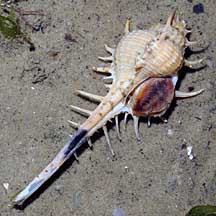The story goes that Hercule's dog was having a jolly good time sniffing around the beach when, lo and behold, he came across an interesting snail. Being a curious fellow, he bit into the mollusc and ended up with his mouth the colour of clotted blood and—voilà!—the first purple dye was discovered. We get our word "purple" from the the colour's Latin name purpura, and the name "Tyrian Purple" references the fact that the city of Tyre (found in modern-day south Lebanon) became known for producing the colour over 3500 years ago.

Cleopatra was apparently a huge fan of purple; when Julius Caesar was hanging around Egypt in 48 BC, he was enamoured by her and her luxurious lifestyle that included a lot of expensive purple things. Her barge was purple, boat sails were dyed purple, sofas were purple, and stones of purple porphyry rock lined her palace. Later, the Byzantine emperors copied this purple stonework, resulting in the phrase "born in the purple" (referring to a royal child of a reigning emperor, and therefore someone of immense privilege). But back to Julius Caesar...
Julius headed home to Rome and decreed that only Caesars were allowed to wear purple togas. Being the only Caesar around, that meant just him. Jump to Emperor Nero's reign, and wearing purple could cost you your life (unless you were the Emperor, obviously). Jump further to the second and third century, and purple was now allowed to be worn freely by women, but men still had to be of the highest rank to wear the colour. My sources seem to contradict each other on this one, but it was, perhaps, not until Diocletian in the third century that purple was legal for everyone to wear—as long as you could pay the hefty tax for the privilege.
As I've mentioned in my posts about Saffron and Cochineal, colours in the olden days had to be created by mashing up the plants, minerals, and creatures around. In the case of purple, this meant macerating millions of snails to release the colouring enzyme. To produce one purple toga, you needed about 1/2 ounce of dye, and therefore at least 250 000 snails. The snails were collected, crushed, salted over three days, and then boiled for ten days. But in order to make sure that the dye stays on the fabric and not wash out, you need a mordant (the French verb mordre means "to bite". Ergo, a mordant 'bites' into the fabric, making the dye hold fast). The rotting snails where often combined with urine (a popular mordant), resulting in purple having a notable smell, to put it mildly.

[...] Purple vats had to be outside the city walls [of Tyre] because no one could live next to the horrible smell made by rotten shellfish soaking in stale urine mixed with wood ash and water. Even the clothes that had been dyed with them had a distinctive odor of fish and sea. The historian Pliny called it "offensive," but for other Romans it was the smell of money. —Victoria Finlay, The Brilliant History of Color in Art

It's a tad misleading that it's called Tyrian purple, as it did not necessarily refer to that bright hue between red and blue that we think of today. Purple could mean a huge range of colours including pink, blue, black and—yes, you guessed it—purple. The exact colour you ended up with depended on which type of snail you used, which mordant you combined it with (you didn't have to use urine; aluminium, tin, and other elements were also available), how many times you bathed the fabric in the dye bath, and even the strength of the sun that day (dyeing under the midday sun could make a pale blue). The Romans highly prized a double-dyed Tyrian Purple that was more of a burgundy or deep crimson (or the colour of "coagulated blood"), but there is the possibility that they could have been wearing pink rather often too.
There's a lot more to say about Purple, but I'll save that for another Wednesday. Thanks to LeeAnne for suggesting Purple. Sources:
Simon Garfield, Mauve
Victoria Finlay, The Brilliant History of Color in Art

